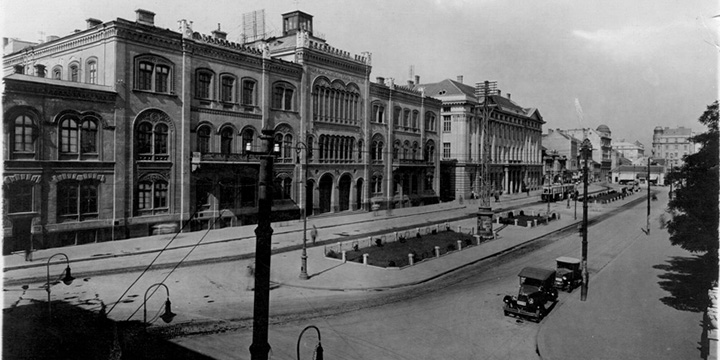
The origin of the University of Belgrade can be tracked down to the beginning of the 19th century, when Dositej Obradović founded the College in 1808.
Thirty years later, the Lyceum was founded in Kragujevac. Transferred to Belgrade in 1841, the Lyceum opened its Law Department, in addition to the already existing Philosophy Department. On September 24, 1863, the Law on the Advanced School Founding was adopted. It was by power of this Law that the Lyceum was transformed into the The Higher School. This institution was situated in the edifice that one of the wealthiest Serbs of the time, Captain Miša Anastasijević, had bequeathed to his fatherland. To this day, this is considered one of the most beautiful buildings in Belgrade.
The Higher School was well recognized not only in Serbia, but also throughout Europe. The most prominent teachers of this School had been educated at the leading foreign universities and they continued to cooperate with their former tutors and colleagues as the representatives of their respective departments.
Early in 1905, the Act on Universities was enacted, and King Peter I signed the decree of its coming into force. It granted the University autonomy, stating that "the teachers are free to present their knowledge". The University of Belgrade was the most important academic institution of the Kingdom of Yugoslavia. Not only was it the heart of scientific, educational and cultural life, but also the centre of resistance to totalitarism. The University gained its reputation through the work of Milutin Milanković, Vladimir Ćorović, Đorđe Tasić, and others.
The University of Belgrade was closed in 1941, when the entire country was occupied by German forces. After the liberation of 1945, the University was reopened by the new communist government. Since the University of Belgrade, as well as the rest of the universities throughout former Yugoslavia, represented the bulwark of democratic ideas and academic freedom between the World Wars, it was put under strict political control. Nevertheless, during the postwar period, the number of Faculties significantly increased.
Under the auspices of the University of Belgrade, the universities in Novi Sad, Niš, Priština, Kragujevac and what is today Podgorica were founded. We can say that the University of Belgrade was alma mater to nearly all the universities throughout Serbia, Montenegro, Bosnia and Herzegovina and Macedonia. In the postwar period, the number of students at the University was constantly increasing. In the early 1960s there were about 50.000 students, and in the academic year 2009/10, 89.482 undergraduates were enroled. The influx of students was encouraged by the liberalisation of enrolment procedure and the possibility of part-time studies. Later on, the enrolment quotas became limited for each Faculty. Currently, only the students who pass entrance exams and have an adequate high school score can matriculate the University. Graduate studies were organized in the 1950s so that students could advance towards the Master of Sciences degree which, from 1966 on, became a precondition for defending doctoral thesis.
It is not possible to fully describe the importance of the University without mentioning its role in the social events of the first fifty years after the World War II, when the country became liberated. The University was the very centre of resistance to retrograde and undemocratic policy of the authorities, from the first student demonstrations in 1968 to the political struggles in the last decade of the 20th century. The latest unrest broke out on October 5, 2000, when students gathered together at the forefront of demonstrations, ultimately leading to the overthrow of Milosević's regime. This confirmed the fact that the University remains the focal point of all social battles.
After a decade of international isolation, the University of Belgrade swiftly came back into the international academic community. It became a member of European and International University Association and was also included into various forms of inter-academic cooperation (such as TEMPUS projects and UNIADRON initiative). Meanwhile, international teacher and student exchange was intensified. In autumn 2004, the University of Belgrade was entrusted with the leading role in preparing a Draft Law on Higher Education. The process of including Serbia into the European Union had to be followed by adjusting its higher education system to the Bologna process.
Nowadays, the University of Belgrade is ready to maintain and improve its role of the leading higher education institution in the area, preserving the traditional values which make it recognized as a prime national brand, but also constantly adapting to new challenges.
site map | Copyright © 2025 University of Belgrade. All rights reserved. | webmaster: icub@rect.bg.ac.rs